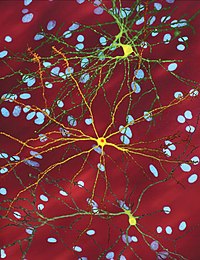
Photo from wikipedia
Ferroptosis is a recently recognized form of nonapoptotic cell death that is triggered by reactive oxidative species (ROS) due to iron overload, lipid peroxidation accumulation, or the inhibition of phospholipid… Click to show full abstract
Ferroptosis is a recently recognized form of nonapoptotic cell death that is triggered by reactive oxidative species (ROS) due to iron overload, lipid peroxidation accumulation, or the inhibition of phospholipid hydroperoxidase glutathione peroxidase 4 (GPX4). Recent studies have reported that ferroptosis plays a vital role in the pathophysiological process of multiple systems such as the nervous, renal, and pulmonary systems. In particular, the kidney has higher rates of O2 consumption in its mitochondria than other organs; therefore, it is susceptible to imbalances between ROS and antioxidants. In ischemia/reperfusion (I/R) injury, which is damage caused by the restoring blood flow to ischemic tissues, the release of ROS and reactive nitrogen species is accelerated and contributes to subsequent inflammation and cell death, such as ferroptosis, as well as apoptosis and necrosis being induced. At the same time, I/R injury is one of the major causes of acute kidney injury (AKI), causing significant morbidity and mortality. This review highlights the current knowledge on the involvement of ferroptosis in AKI via oxidative stress.
Journal Title: International Journal of Molecular Sciences
Year Published: 2022
Link to full text (if available)
Share on Social Media: Sign Up to like & get
recommendations!